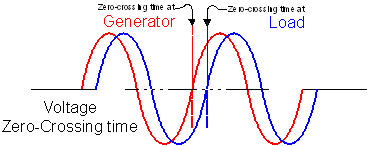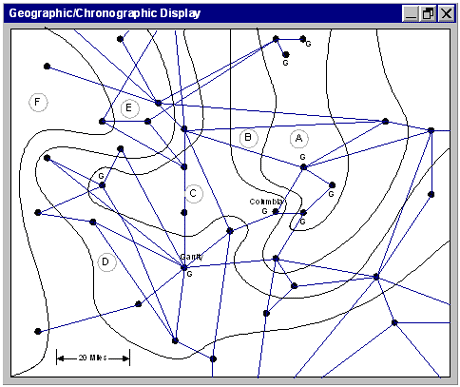
Transmission Use Evident from Cycle
Timing
Feb 22, 2005 David Tuck, energypulse.net
A three-phase transmission line is an electrical
model of a rotating shaft. A drive shaft under heavy
load will exhibit a small amount of torsion between
the power head and the load end. Similarly, the load
end of an electrical line will lag the generation
end by a small but measurable amount. The familiar
sine wave is representative of an AC voltage, and
if an event recorder monitoring voltage captures the
exact time it rises through zero at the generator
while another event recorder captures the time at
a load substation, then both times can be compared
(see Figure 1).

Figure 1: Measure Zero-Crossings
The difference between the two times won’t
translate directly to MWhs of flow, but it will be
a relative measurement based upon actual energy flow,
line capacity, and distance. The time difference will
convey a wealth of system information when used in
conjunction with voltage measurements taken from the
other substations in the neighborhood.
In this way, this article proposes to use voltage
cycle timing to determine relative transmission line
loading. It is based on the time differences in measured
voltage events (zero-crossings of a selected phase)
at multiple locations across a synchronized system.
By accepting cycle timing as a metric, reliability
coordinators would be able to quantify power flow
and transmission line strength by comparing single
instantaneous value per voltage level from different
substations. Furthermore, readings taken anywhere
within the interconnected area would be meaningful
everywhere else regardless of region, control area,
or state borders.
To make sense of this, a precision event recorder
capable of time-stamping voltage events with microsecond
accuracy must be placed in every substation at every
voltage level. Each recorder, synchronized to Universal
Time via GPS, reports the time-stamp of selected cycles
and submits them to a central web server. The server
receives and stores the information into a time-structured
database. Time, as the subject of the metric, will
be used in interesting ways.
Displays to Represent Area Timing
The gathered information, once received and stored,
could be displayed in a geographic map of substations
and transmission lines. The chronographic aspect could
be shown as zones of difference where contour lines
clearly indicate bands of common cycle time difference.
See Figure 2 below where generator substations (labeled
‘G’) lead other areas in bands of time
difference. Visualize the view to be similar to a
contoured map showing elevation—in this case
the generators are the peaks and high plateaus while
loads are ‘downhill’, or at least down
sloping, to valleys. The actual course taken by the
energy flow can be visualized as elevation drop along
transmission lines of the map, which is actually represented
by time difference through the many contour lines
between substations.

Figure 2: Geographic/Chronographic Display
In this view, the transmission line between Garrity
and Columbia is intersected with no time boundary
contour lines while there are 3 contours on the line
going South of Garrity. This reveals that relatively
light loading exists between the two generators, but
relatively heavy loads reside to the South.
The display works because a time-stamp measurement
taken when voltage at the source crosses zero always
occurs ahead of the sink by a measurable amount. What
will be the time measurements where there are numerous
generators and loads distributed over the map? The
answer, obviously, is that the zones with greater
generation will lead zones with greater load. Due
to the physics of the electric system, all components
will quickly seek their place in time, and although
still synchronized, will exhibit time differences
that will indicate the actual direction the energy
flows.
Visibility of Instability
Today, the electric industry achieves and maintains
60Hz synchronization across the national power grid
using sophisticated methods involving generator control
equipment. However, the grid itself is far from being
rock-solid stable. It is influenced by every change
of load and every change in generation. The energy
behind the generators tries to speed-up rotational
frequency while the load tries to slow it down—all
being held in check by control equipment. In fact,
the entire interconnected grid exactly matches generation
to load. Inadvertent differences are manifested in
deviations of frequency away from exact 60Hz. Too
much generation, the frequency rises above 60Hz—too
much load, it drops below 60Hz. With the grid operating
like a roiling sea of turmoil, shifting contours will
highlight oscillations. Consider Figure 3 in relationship
to Figure 2. If these two displays alternated separated
by one or two seconds, it would reveal a struggle
between Garrity and Columbia generators. This struggle
would indicate system instability and consuming excess
generator fuel, capacity, and causing a certain amount
of needless transmission losses.

Figure 3: Contour Shape Fluctuations Evident
Timing Reference
This system is dependent upon all substation sites
to be precisely time-synchronized together. Each site
can do this using the timing features of the Global
Positioning System (GPS), which produces a synchronized
and accurate timing pulse to sub- microsecond accuracy
to Universal Time regardless of world location. Once
synchronized, substation recorders can measure their
time and report the difference between it and the
reference.
To establish a universal reference, NERC could simply
state that there shall be exactly 60 pulses per second
with the first pulse arriving exactly at the 1-second
mark. This is not really a new concept; NERC has always
worried about frequency. But to establish a true reference,
there must be a start stating that this particular
cycle is the beginning, and from now on, all cycles
will be based from it. Thanks to the wandering nature
of frequency, it is well known that such a reference
could lead or lag its intended place in time by multiple
seconds.
Another possibility is to allow the reference to
be ‘in the clock of the beholder’. In
other words, a control area could monitor every substation
inside itself and declare the reference to be the
leading measurement, and all other measurements would
be shown as time offsets from it. Therefore, the leading
generator has zero time difference and each other
substation lags it by a certain number of microseconds.
Since there are approximately 16,667 microseconds
per cycle, each degree of generator shaft rotation
is 46.296 microseconds. This measurement accuracy
is well within measuring capability of today’s
synchro phasors and high-speed event recorders, and
would certainly provide adequate time bands from which
to build map contours.
So Many Measurements, So Little Time
The author has constructed event recorders with
fast enough time-stamping capability to verify the
concepts purported herein. The table below is a sample
of recently captured time-stamps from two substations
separated by an estimated 18 miles (where ss=substation
code, vvvv=voltage, ssssss=Garmin seconds, mmmm=milliseconds,
and uuuuu=number of 1/20 microseconds):

Although these measurements are anecdotal, the author
believes that the 107 uSec lag of substation V2 behind
V1 indicates a robust flow towards V2. (If the distance
between the two substations is 18 miles as believed,
the voltage waveform should exhibit a difference of
about 96 uSecs accounting for the speed of light for
the voltage waveform to travel the distance. The fact
that it took 11 uSec longer indicates a certain amount
of loading on the line.)
The information that would have been sent across
a wide area network for this single comparison would
have amounted to a raw 25 characters per measurement.
Inside the central processor’s data storage,
the time value for each substation could be stored
as the raw time reading and a difference value. V1’s
difference would store 0 (because it is the leading
sub) and V2’s difference would store 107 (because
it is lagging the reference by 107 microseconds).
Naturally, there could be 60 of these stamps per second,
and the database could store the integrated difference
as a single ‘average over a second’ integer.
Or, if desired, it could store 60 seconds as an integrated
‘average over a minute’ integer. And,
by extension, hourly averages can be derived as well.
For making historical records, all the above may be
desirable, and after a few months of history is correlated
with integrated MWh readings, future hours could be
forecast.
Conclusion: A New Generation of Metering Equipment
This new time-stamping event recording meter along
with its data accumulator and contour map displays
(patent pending) as proposed in this article would
be an inexpensive step in allowing all electric providers
to make lower voltage measurements and yet easily
see the flow of system load as a relative picture
on a geographic/chronographic display. Such a meter
can be cheaply placed in a substation, connected to
a voltage device on a single phase, to a GPS receiver,
and to the Internet. It could transmit time measurements
only, or add other available features with small incremental
costs. A web server at the control center could handle
the data accumulation and storage with traditional
time-oriented database applications and new software
designed to retrieve, sort, and replay captured events.
When future hour forecasts are made, E-Tag and pending
schedule approvals could be easily tested—just
ensure that no Point-of-receipt to Point-of-delivery
path segments crosses too many contour lines!
Reliability centers would desire this type of information
to monitor system health in real time. Marketers and
power agents would desire this type of information
to help them schedule energy across transmission paths
that exhibit few contour lines crossing the path.
The metric information from around the nation could
be sold to subscribers where they may view regions
in a real-time or historically integrated history
display map. Such may help simplify decisions of energy
scheduling and help open competition in the electric
industry.
l

|






